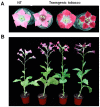Enhancing Flower Color through Simultaneous Expression of the B-peru and mPAP1 Transcription Factors under Control of a Flower-Specific Promoter
- PMID: 29361688
- PMCID: PMC5796253
- DOI: 10.3390/ijms19010309
Enhancing Flower Color through Simultaneous Expression of the B-peru and mPAP1 Transcription Factors under Control of a Flower-Specific Promoter
Abstract
Flower color is a main target for flower breeding. A transgenic approach for flower color modification requires a transgene and a flower-specific promoter. Here, we expressed the B-peru gene encoding a basic helix loop helix (bHLH) transcription factor (TF) together with the mPAP1 gene encoding an R2R3 MYB TF to enhance flower color in tobacco (Nicotiana tabacum L.), using the tobacco anthocyanidin synthase (ANS) promoter (PANS) to drive flower-specific expression. The transgenic tobacco plants grew normally and produced either dark pink (PANSBP_DP) or dark red (PANSBP_DR) flowers. Quantitative real time polymerase chain reaction (qPCR) revealed that the expression of five structural genes in the flavonoid biosynthetic pathway increased significantly in both PANSBP_DP and PANSBP_DR lines, compared with the non-transformed (NT) control. Interestingly, the expression of two regulatory genes constituting the active MYB-bHLH-WD40 repeat (WDR) (MBW) complex decreased significantly in the PANSBP_DR plants but not in the PANSBP_DP plants. Total flavonol and anthocyanin abundance correlated with flower color, with an increase of 1.6-43.2 fold in the PANSBP_DP plants and 2.0-124.2 fold in the PANSBP_DR plants. Our results indicate that combinatorial expression of B-peru and mPAP1 genes under control of the ANS promoter can be a useful strategy for intensifying flower color without growth retardation.
Keywords: anthocyanin; flower color; flower-specific promoter; tobacco; transcription factor.
Conflict of interest statement
The authors declare that they have no conflict of interest.
Figures






References
-
- Katsumoto Y., Fukuchi-Mizutani M., Fukui Y., Brugliera F., Holton T.A., Karan M., Nakamura N., Yonekura-Sakakibara K., Togami J., Pigeaire A., et al. Engineering of the rose flavonoid biosynthetic pathway successfully generated blue-hued flowers accumulating delphinidin. Plant Cell Physiol. 2007;48:1589–1600. doi: 10.1093/pcp/pcm131. - DOI - PubMed
MeSH terms
Substances
LinkOut - more resources
Full Text Sources
Other Literature Sources
Research Materials
Miscellaneous

